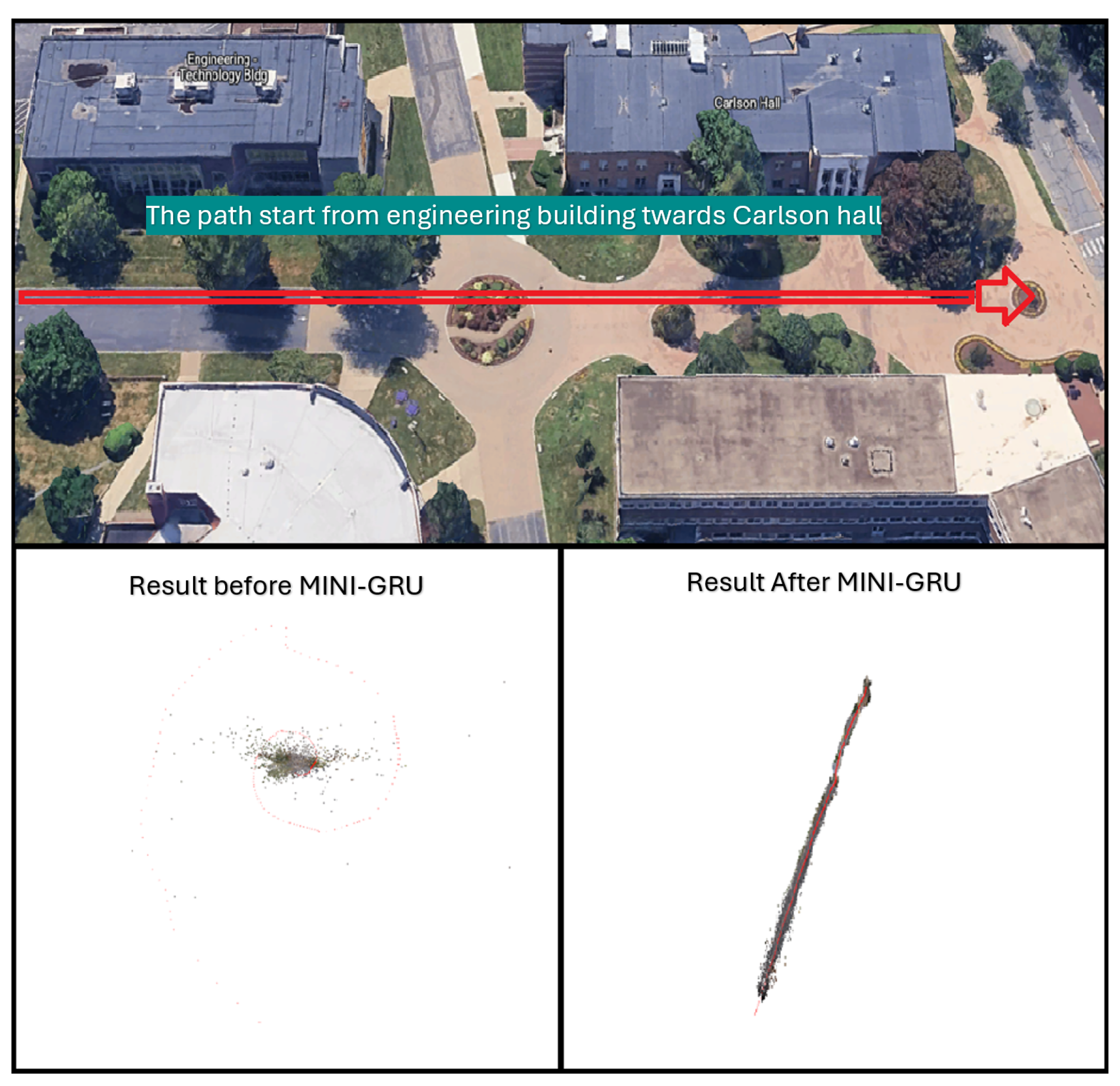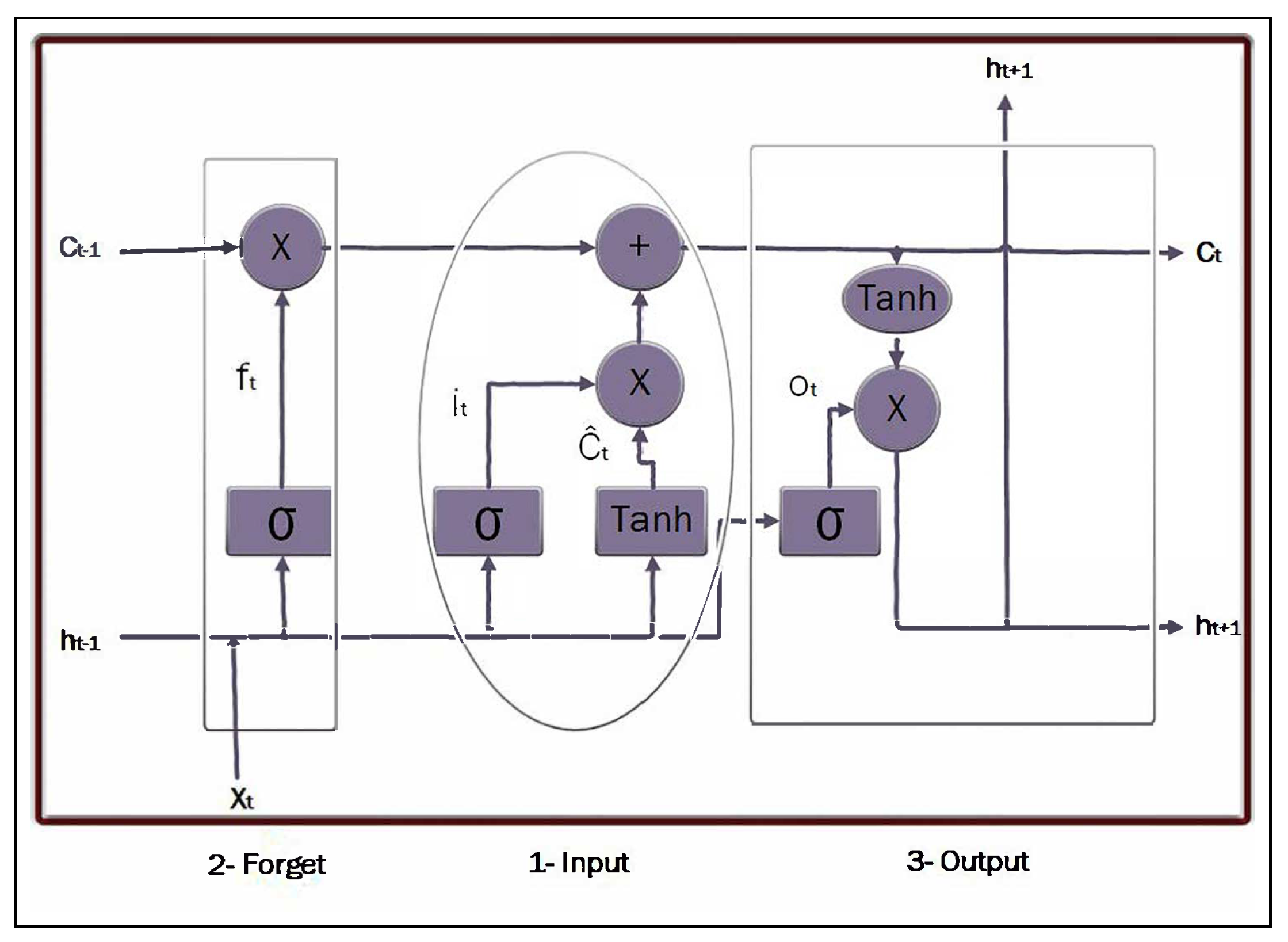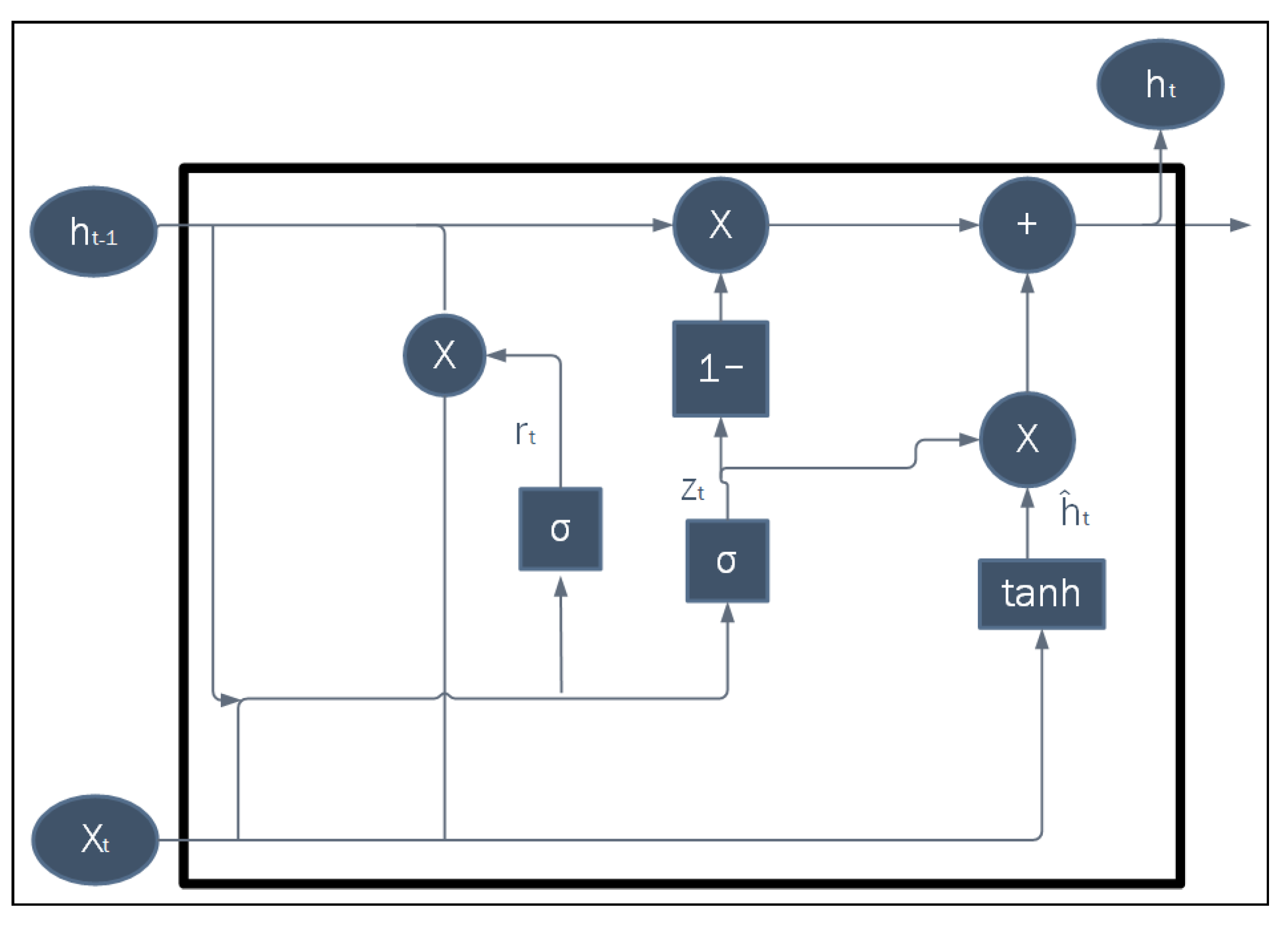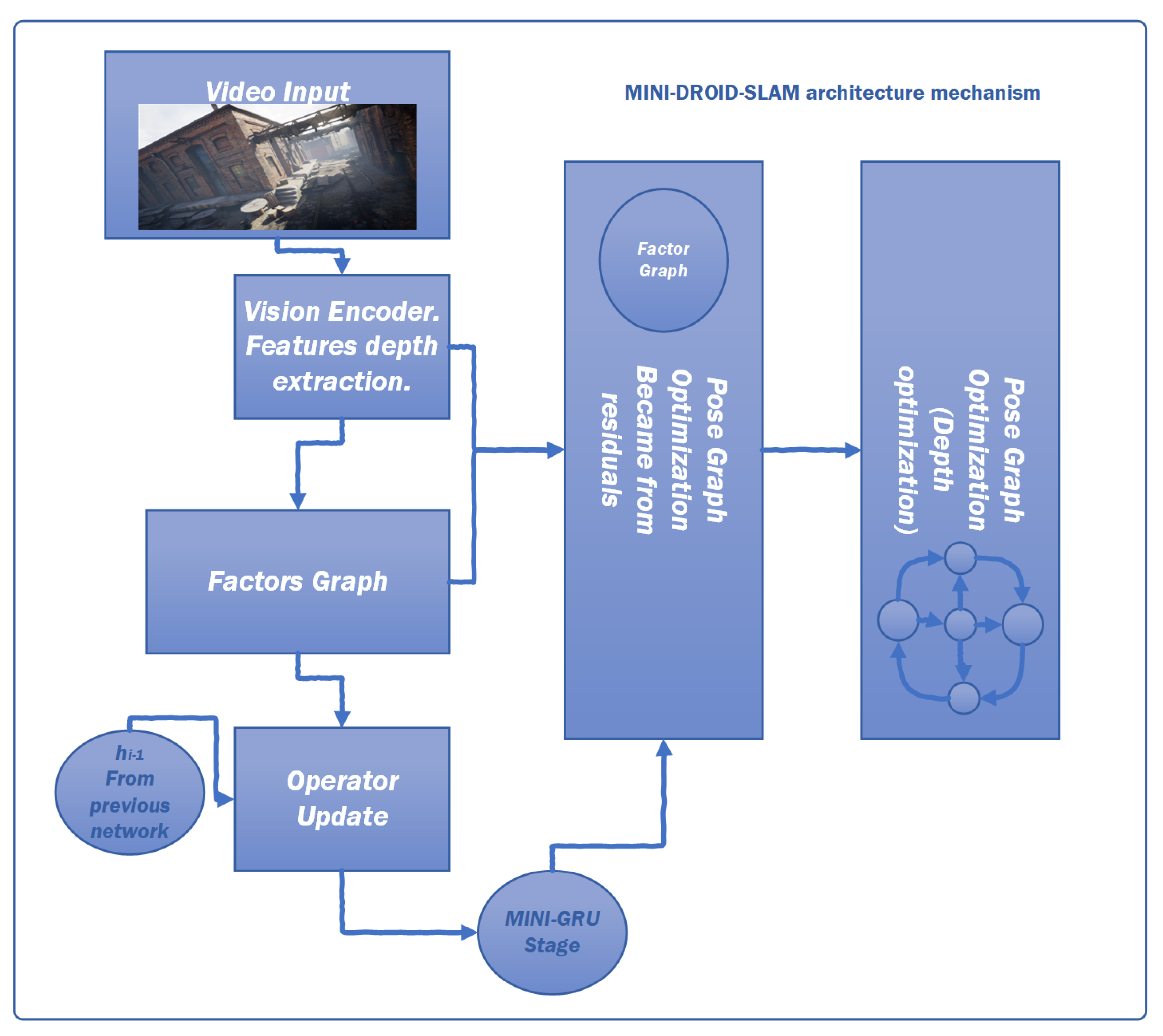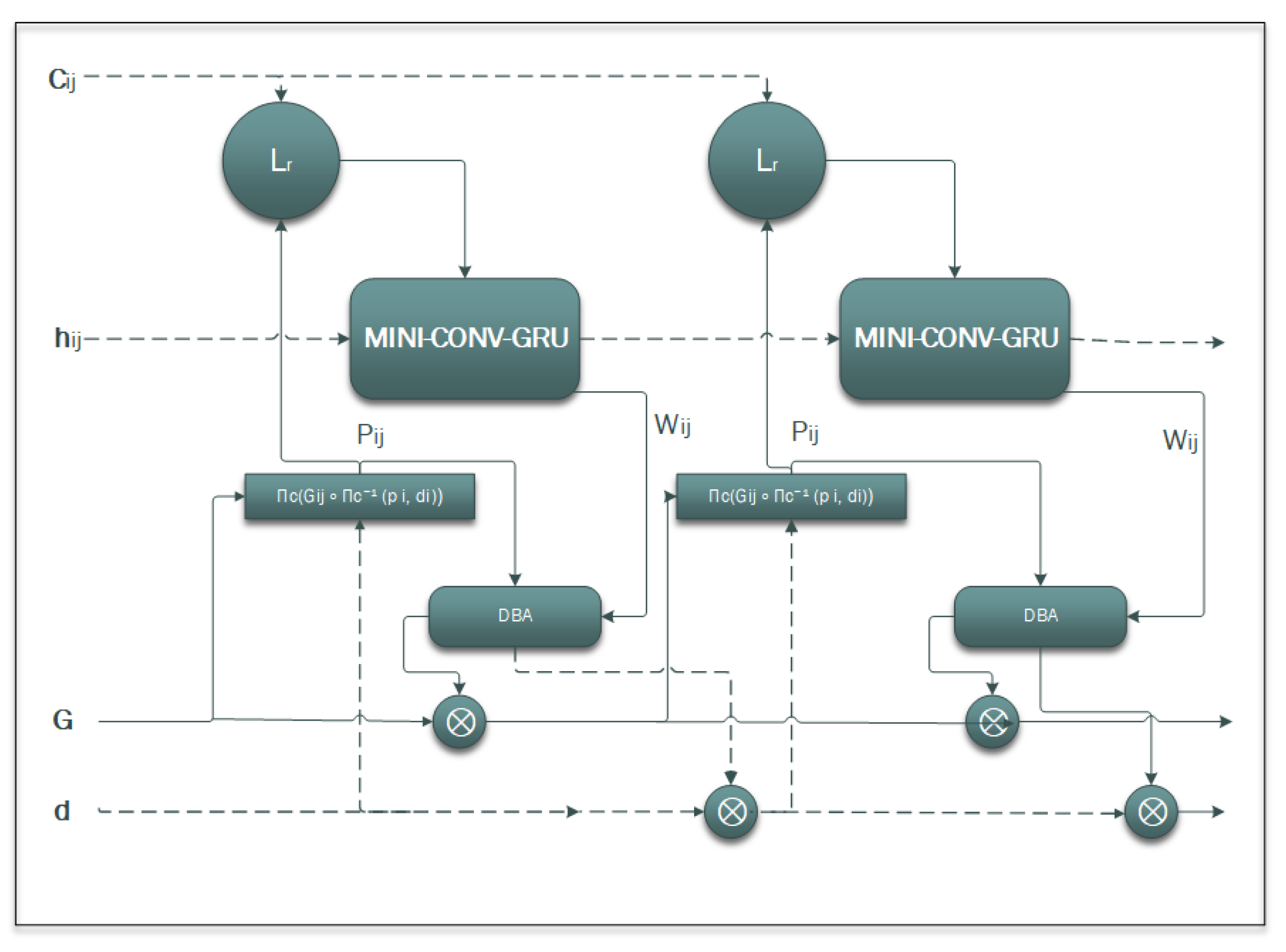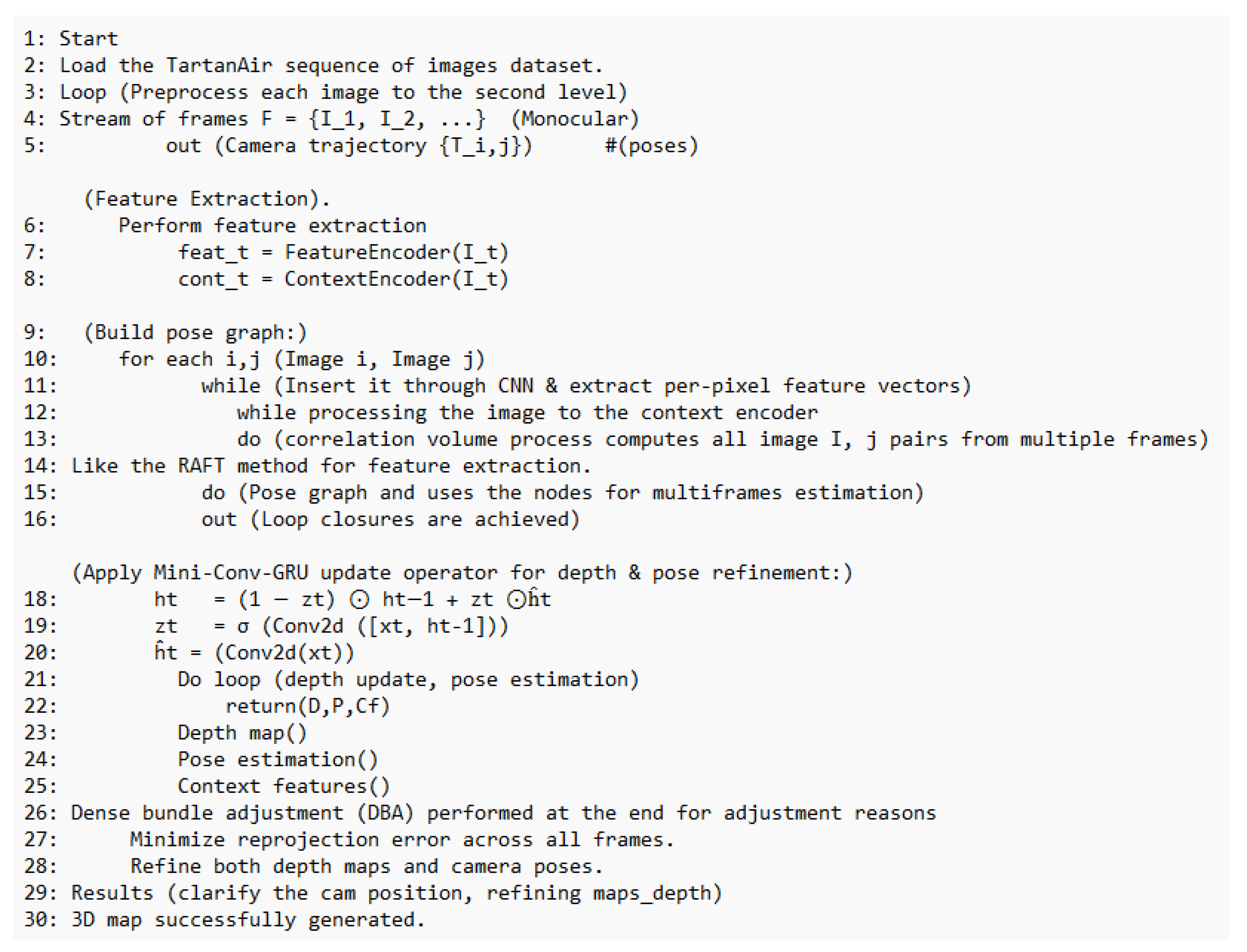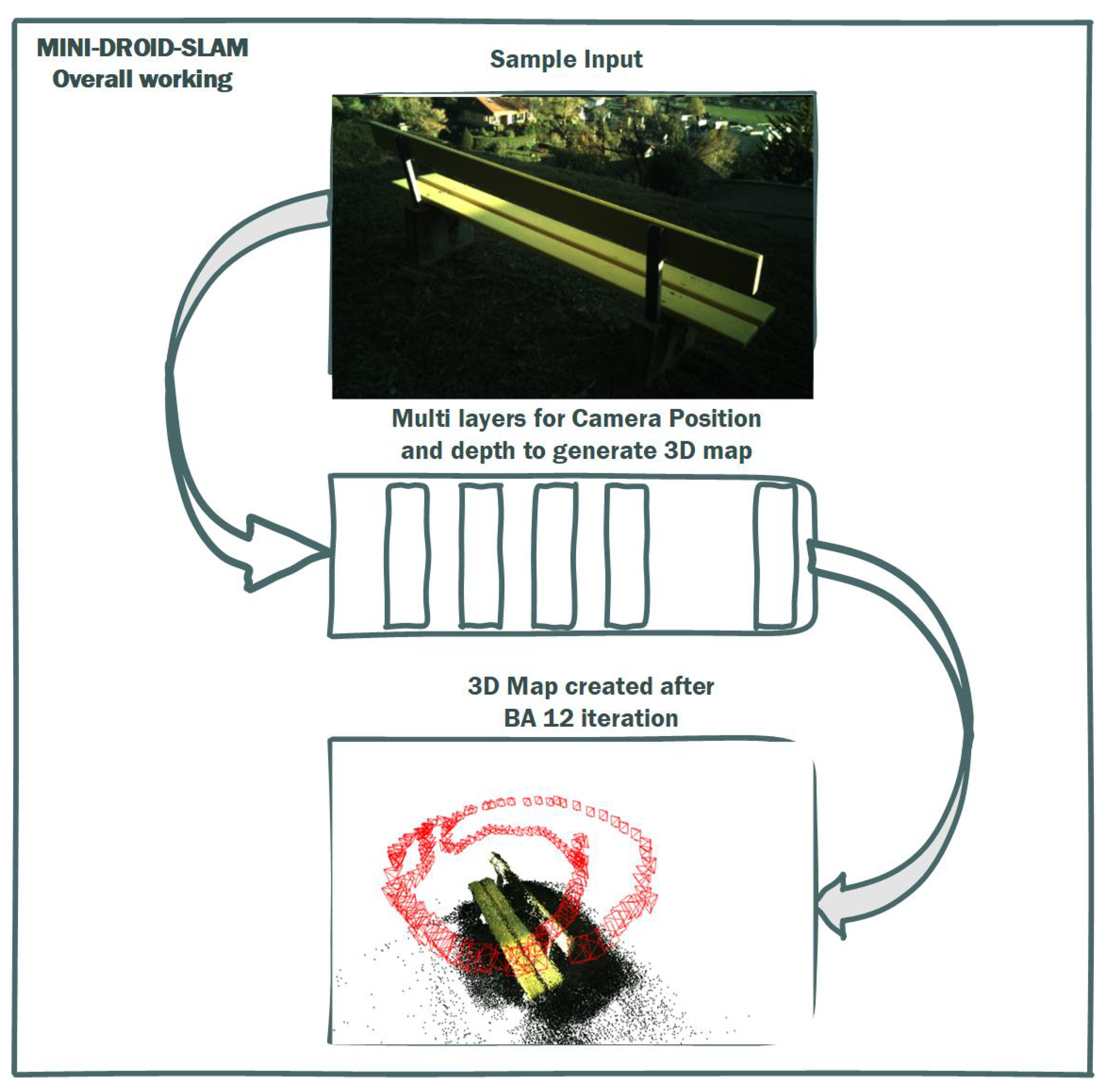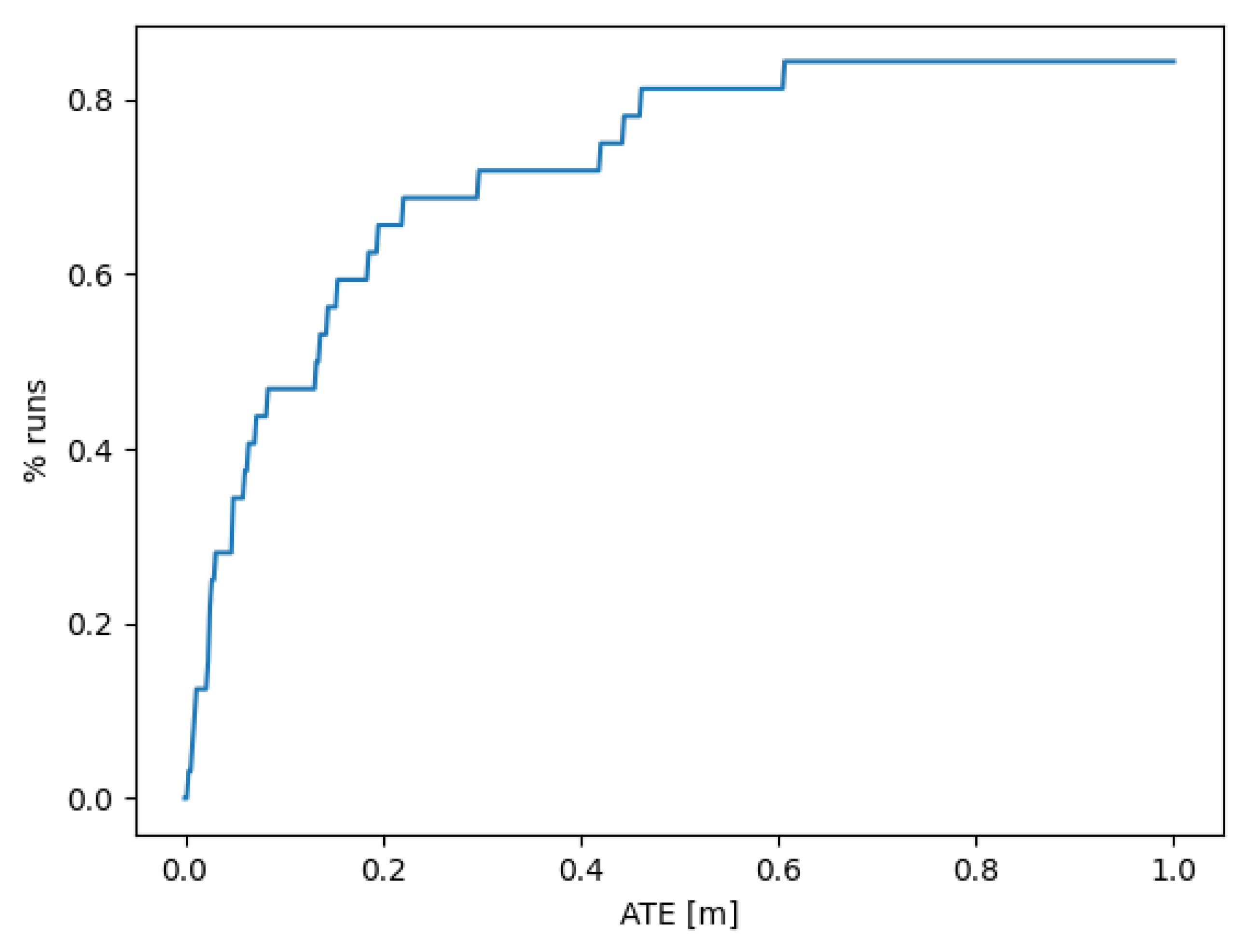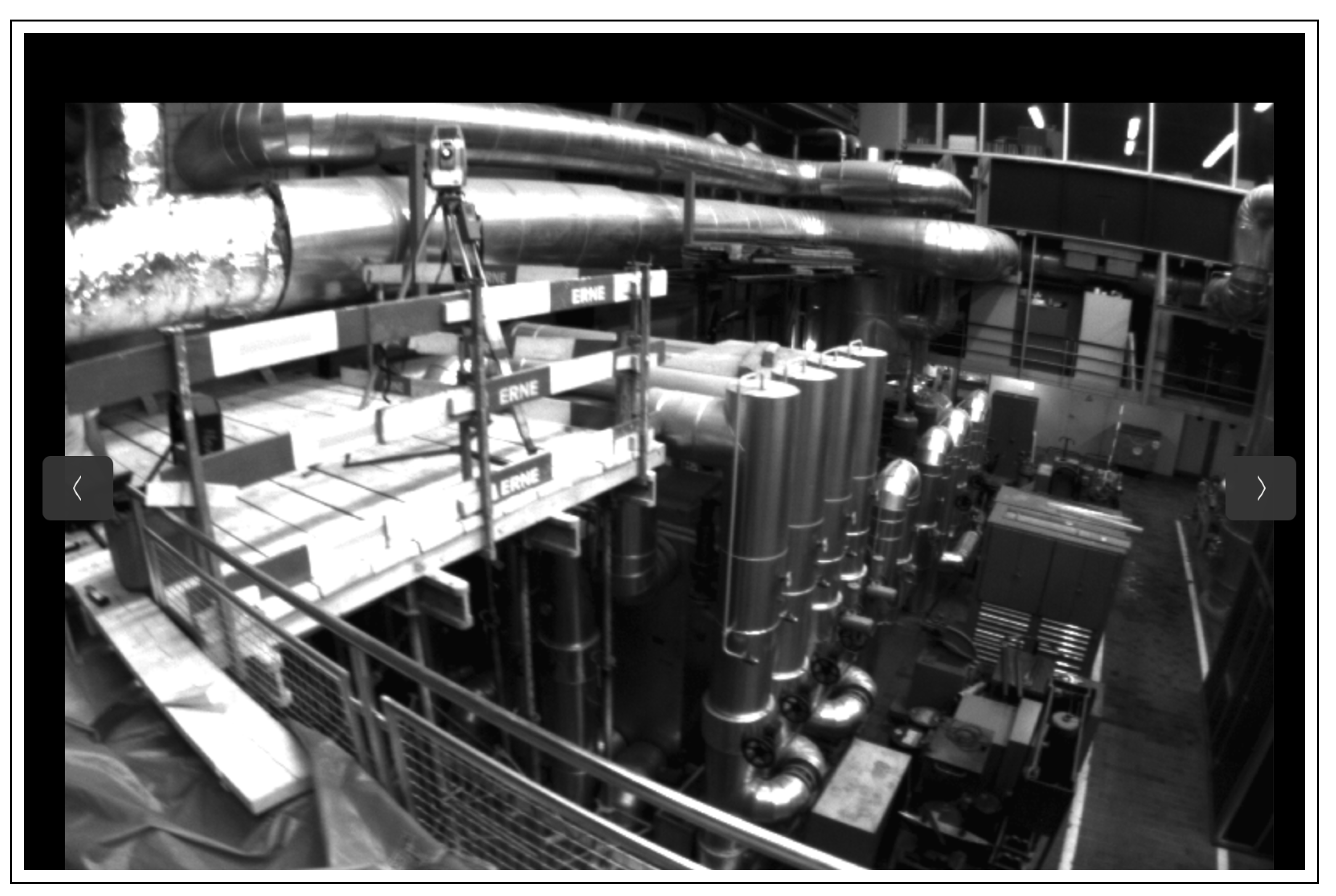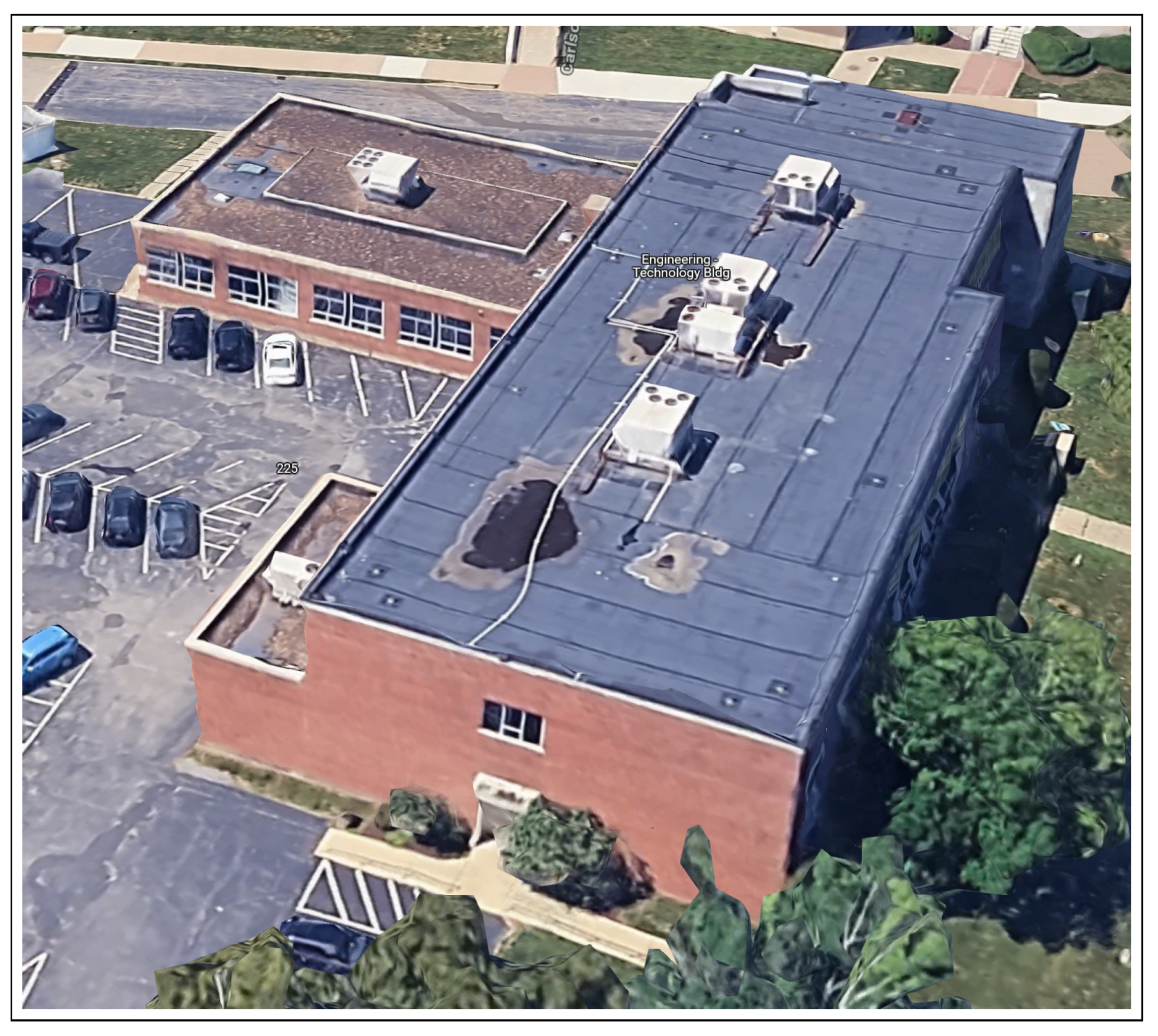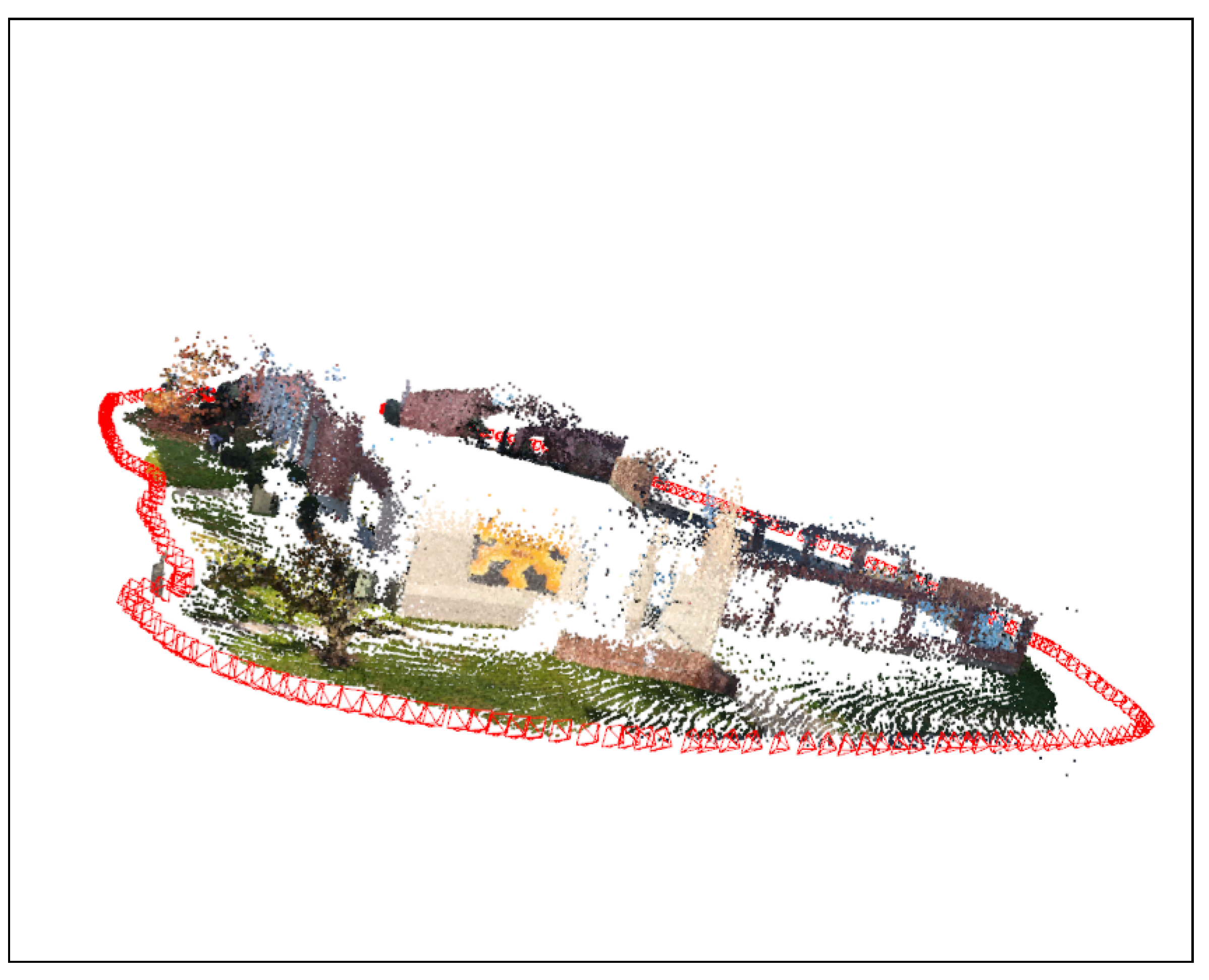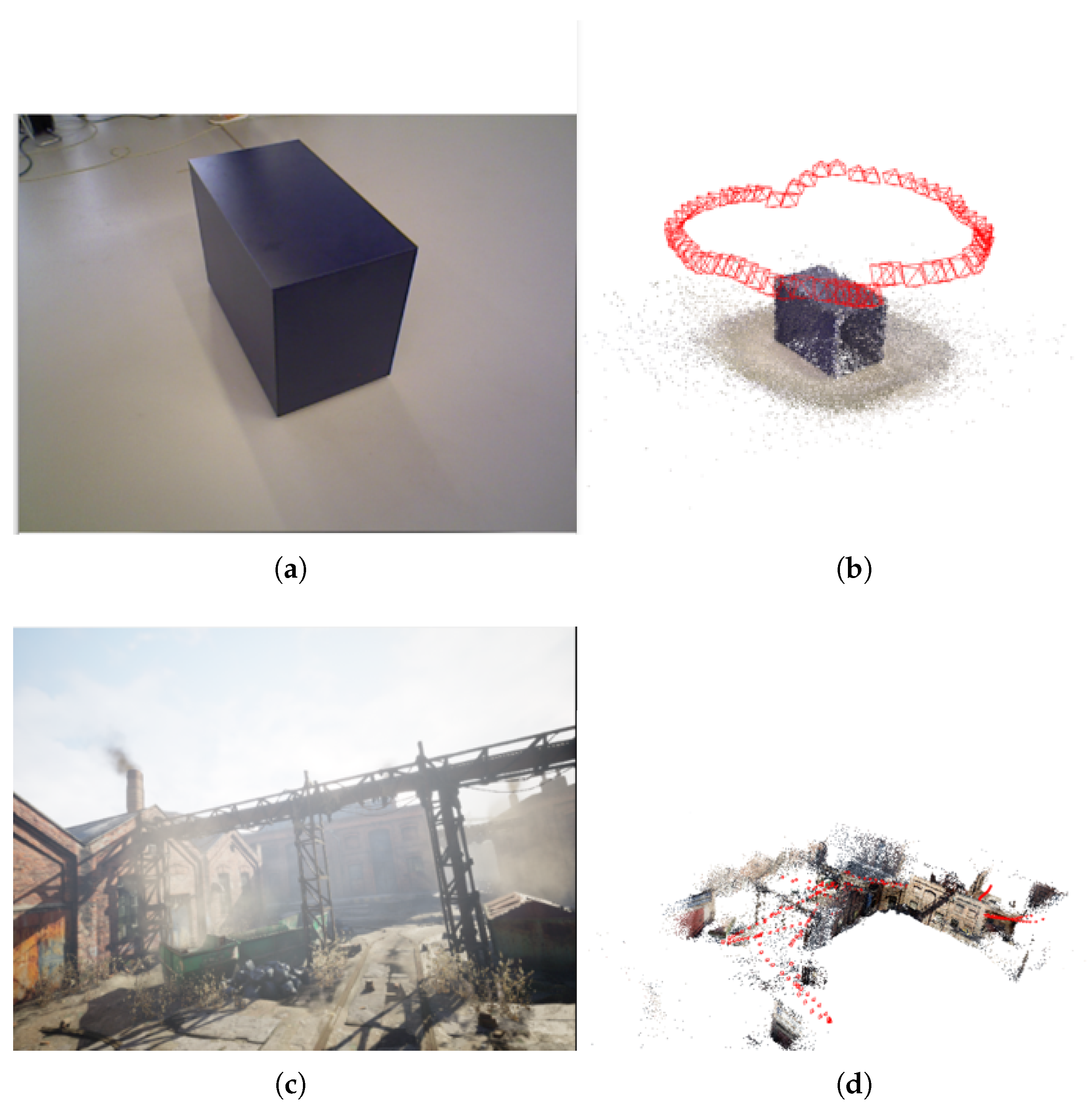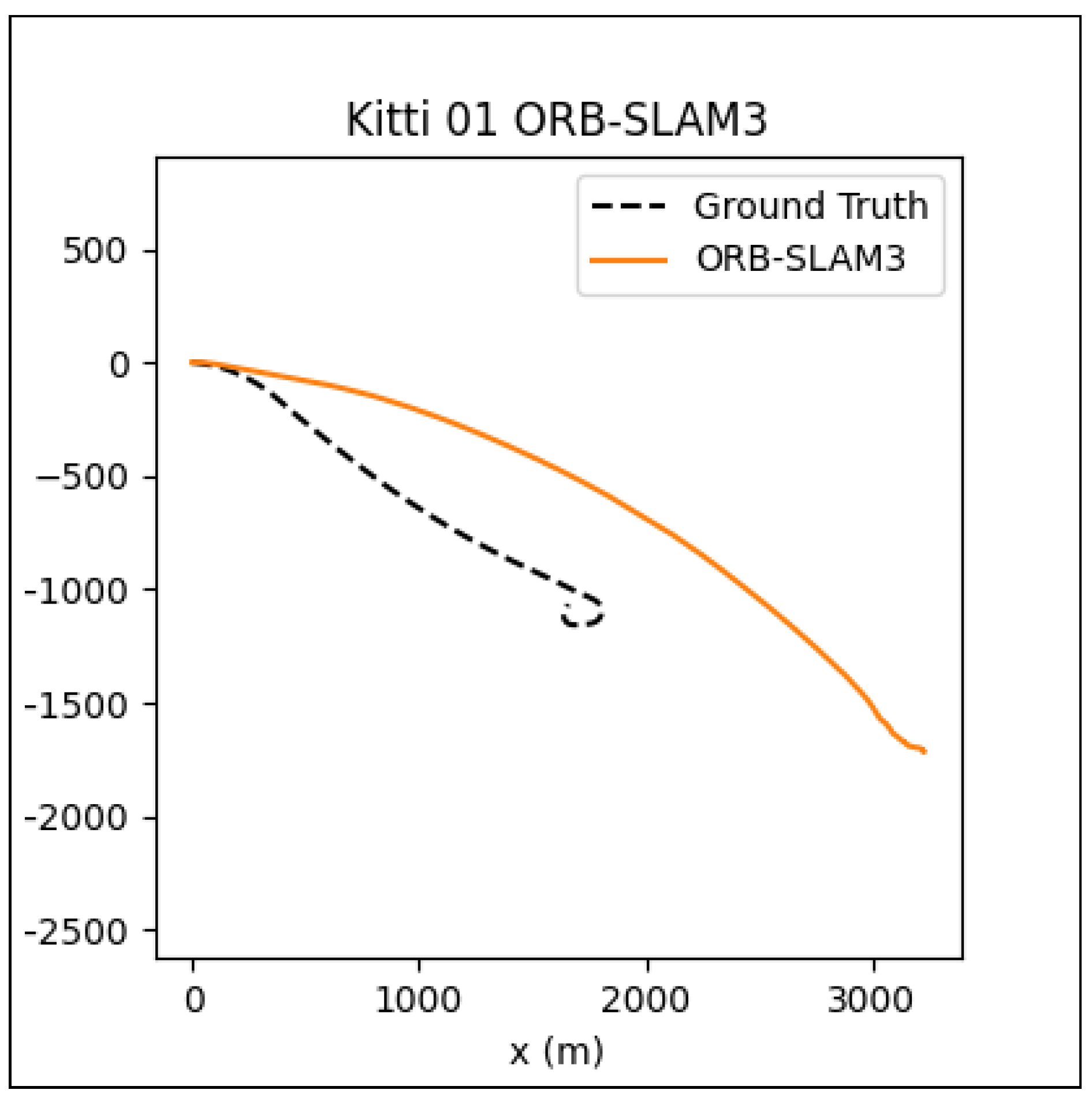1. Introduction
Simultaneous Localization and Mapping (SLAM) is an indispensable technology that enables autonomous systems to concurrently construct a map of an unknown environment while simultaneously determining their own position within that map. This dual capability is fundamental for navigation and understanding new environments. SLAM systems commonly integrate data from multiple sensor modalities to enhance map quality and robustness. These sensors typically include cameras (monocular and stereo), depth sensors, and Light Detection and Ranging (LiDAR). The incorporation of advanced algorithmic techniques, such as those that support dense reconstruction or feature visualization, significantly improves the system’s ability to recognize and adapt to novel environments. In essence, SLAM empowers autonomous agents to navigate and comprehend their surroundings by concurrently localizing themselves within a newly generated map [
1]. A prominent variant of SLAM is Visual SLAM (VSLAM), which heavily relies on visual sensors for its operations. VSLAM systems typically utilize data from monocular cameras, stereo cameras, and, in some cases, LiDAR, to achieve robust performance. A key strength of VSLAM lies in its ability to generate real-time maps by leveraging distinctive visual features extracted from the environment. This characteristic makes VSLAM particularly well-suited for applications demanding high fidelity and real-time environment discovery. Both general SLAM and VSLAM methodologies are critically dependent on their abilities to construct new maps robustly, a vital capability for applications such as autonomous vehicles and drones [
2]. This research highlights a clear trend towards more efficient, accurate, and robust SLAM systems powered by deep learning.
Figure 1 shows the SLAM output for a real-time sample where DROID-SLAM failed to converge to the correct environment map, while MINI-DROID-SLAM was used to build an accurate map for the new environment. The main contributions of the paper can be summarized as follows:
Introduction of a new DROID-SLAM architecture based on the Mini-GRU RNN network.
Improvement on the training performance on the newly proposed model.
Reduction in the minimum hardware requirements from 4 GPUs to 1 GPU.
Introduction of MINI-DROID-SLAM, a lightweight DROID-based Monocular-SLAM system that is suitable for real-time requirements.
Figure 1.
Result of DROID-SLAM (to the left), and MINI-DROID-SLAM (to the right) on a real-time example.
Figure 1.
Result of DROID-SLAM (to the left), and MINI-DROID-SLAM (to the right) on a real-time example.
This proposed work maintains the robustness of deep SLAM frameworks while making them more accessible for real-time systems and embedded applications. For validation, this paper evaluates MINI-DROID-SLAM on various datasets using a monocular camera, as shown in the real-world example in
Figure 1, the TUM-RGB dataset, the EuRoC dataset, and finally on the synthetic TartanAir dataset, demonstrating competitive performance and significantly reduced computational overhead.
2. Related Works
Recent research has significantly advanced Simultaneous Localization and Mapping (SLAM) systems through the integration of deep learning methodologies, yielding enhanced performance. A notable example is the application of Visual SLAM (VSLAM) techniques for constructing dense 3D maps, as demonstrated with datasets like TartanAir [
3].
In 2022, Zachary Teed and Jia Deng introduced DROID-SLAM [
4], a pioneering framework that fuses deep learning with traditional SLAM paradigms to achieve highly accurate and robust VSLAM. DROID-SLAM’s architecture is built upon a recurrent iterative update mechanism, inspired by the RAFT model [
5], which refines camera poses and pixel-wise depth estimations. The system then employs Dense Bundle Adjustment (DBA), enabling it to process a diverse range of input types, including monocular, RGB-D, and stereo data. To manage inter-frame relationships and dependencies within video streams, DROID-SLAM utilizes a Frame Graph Representation, which facilitates efficient loop closure and optimization. A core innovation lies in its deep learning model, which extracts updates for poses and depth by minimizing geometric errors through state-of-the-art optical flow estimation, to refine predictions iteratively. The model’s efficacy was validated across multiple datasets, including TartanAir, EuRoC, TUM-RGBD, and ETH3D-SLAM, demonstrating robust performance without requiring any retraining. Although it was initially trained on four NVIDIA 3090 GPUs for approximately one week using the TartanAir dataset, the model’s efficacy was demonstrated across various datasets.
In late 2024, the same authors presented DPV-SLAM, an evolution of their DROID-SLAM approach, with a primary focus on improving the efficiency of the loop closure mechanism, while DROID-SLAM incorporated both proximity-based and classical loop closure techniques (image retrieval and pose graph optimization for scale drift correction), DPVO’s redesigned architecture significantly enhances efficiency. This new design enables DPV-SLAM to operate effectively on a single GPU, supporting high frame rates and minimizing memory consumption. Comparative analyses against DROID-SLAM revealed that DPV-SLAM achieves comparable accuracy while being 2.5 times faster, with no observed failures in either indoor or outdoor environments. It is worth noting that DPV-SLAM is an extended version of the DPVO visual odometry system [
6].
To continue, several other deep-learning-based SLAM systems have emerged, each with unique contributions, including the following types: iMAP, which utilizes a multi-layer perceptron (MLP) for inferring scene representation and rendering [
7]. This system employs RGB-D cameras for real-time training, eliminating the need for prior data to construct dense 3D occupancy and color models. iMAP integrates key frame structures, multi-processing, and dynamic pixel sampling to achieve efficient tracking and global map updates. It excels in scene representation, detail control, and filling unobserved areas, often surpassing traditional SLAM systems in completeness and memory efficiency. Its real-time training capability marks a significant step towards dense real-time SLAM with incremental training and implicit neural representation. Volume-DROID is a real-time SLAM system that combines volumetric mapping with the DROID-SLAM framework [
8]. It processes both RGB-D and monocular camera inputs to create 3D maps and accurately track robot localization. A key innovation is the real-time integration of DROID-SLAM with the ConvBKI algorithm, which optimizes data processing efficiency. The system leverages optimized camera positions and point clouds from RGB-D frames to enhance mapping accuracy for autonomous navigation, while evaluations on the TartanAir dataset showed promising performance, challenges with semantic segmentation were observed due to label mismatches. DVI-SLAM enhances accuracy and reliability by integrating visual and inertial (IMU) data, a feature shared with prior deep learning methods, such as DROID-SLAM [
9]. This hybrid model uniquely blends various visual data types, adjusting their impact based on confidence levels, resulting in a significant reduction in tracking errors for moving objects within datasets such as TartanAir and EuRoC. DVI-SLAM demonstrates flexibility across different sensor configurations and has been successfully tested on both datasets and real-time data. However, identified limitations include processing speed, memory usage, and sensor integration complexities.
Further enhancements to the DROID-SLAM framework for visual odometry have involved integrating Global Self-Attention and Atrous Spatial Pyramid Pooling (ASPP) into its Conv-GRU model [
10]. This modification expands the receptive field, enabling improved optical flow estimation in challenging environments, while the original DROID-SLAM occasionally outperforms these modifications on specific datasets, these enhancements generally improve DROID-SLAM’s accuracy and memory efficiency. GO-SLAM is a deep-learning-based real-time SLAM system designed for reliable 3D reconstruction using RGB-D, monocular, or stereo camera inputs [
11]. It reduces trajectory errors through online loop closing and full Bundle Adjustment, achieving superior performance compared to earlier techniques such as DROID-SLAM and iMAP. Operating at 8 FPS with 18 GB of GPU RAM, GO-SLAM demonstrates strong performance in large-scale environments. Optimal performance is achieved through careful key frame selection and loss configurations, leading to cutting-edge results in position estimation and 3D reconstruction across various datasets. Rover-SLAM is a real-time visual-SLAM framework that incorporates deep learning to enhance performance in challenging conditions [
12]. It supports diverse camera configurations, including monocular, stereo, monocular–inertial, and stereo–inertial data. The framework utilizes advanced feature extraction and matching algorithms, specifically SuperPoint and LightGlue, to enhance adaptability in dynamic lighting conditions and weakly structured environments. Rover-SLAM achieves high localization accuracy and robust tracking performance comparable to existing SLAM systems. SPAQ-DL-SLAM (Structured Pruning and Quantization) is an optimization framework developed for deep learning SLAM models, particularly DROID-SLAM, to enable their deployment on resource-constrained devices [
13]. This optimized version achieves a 20% reduction in model size and an 18.9% decrease in computational complexity, while improving accuracy by 10.5% on the TUM-RGBD dataset. For the SPAQ-DL-SLAM, the enhancements stem from two main steps: structured pruning, which reduces computational demands, and post-training quantization (PTQ), which converts the model’s data from 32-bit to 8-bit integers, maintaining accuracy while improving hardware efficiency; while it is effective across various datasets, this approach struggles in environments with high angular velocity. On the other hand, several newer versions of the GRU modules have been recently introduced, as in [
14], where the authors claim a lightweight architecture, yet they still utilize activation functions like Tanh in the input state. Additionally, the proposed models in their research are also used for other applications, rather than SLAM systems [
14]. Moreover, in 2025, another research group used a multiscale GRU. For that model, the authors are still using a large number of parameters [
15], even more than the original GRU. However, as will be introduced in the next section, the MINI-GRU model is a lightweight RNN network designed for sequential data, such as in Visual SLAM systems. The main concept of MINI-GRU is to reduce the parameters from the original GRU blocks. As a result, MINI-CONV-SLAM, the convolutional version of the MINI-GRU, achieves high performance and accuracy while reducing computational complexity.
4. Methodology
Considering the advantages of the MIN-GRU presented in the previous section, this paper proposes enhancements and modifications to the DROID-SLAM deep learning Simultaneous Localization and Mapping (SLAM) system. Specifically, it replaces the utilized CONV-GRU module with a modified version of the state-of-the-art MINI-GRU module, known as MINI-CONV-GRU.
Table 2 presents a comparison between fully connected neural networks (Basic NN), CONV-GRU, and MINI-CONV-GRU modules, focusing on their suitability for real-time applications. The proposed system utilizes the BA (Bundle Adjustment) for pixel-wise depth, precisely as the DROID-SLAM technique does. The proposed system architecture is shown in
Figure 6. The proposed system targets monocular camera data; therefore, only monocular Tartanair datasets will be used in the training process. The process starts by extracting features from the input image. The features are extracted using a network of six residual blocks and three downsampling layers similar to the original DROID-SLAM architecture to produce a dense feature map that is used to build the
, input to the update process, as shown in
Figure 7. Those correlation features are indexed using the
, correlation lookup operator. Another context network works on the input image to produce context features that are also used in the output update step. Similar to the original technique, the dense corresponding field
is calculated and used in both the indexing process and the BA step.
Figure 8 illustrates the process in algorithmic steps.
Update Operator in MINI-DROID-SLAM
After the input sequences are processed for feature extraction and indexing, the data are applied to the MINI-CONV-GRU to produce updated information for the output level.
Figure 7 illustrates the
update operator, which is the central core of MINI-DROID-SLAM, utilizing the MINI-CONV-GRU module, and is responsible for refining camera poses and dense depth maps iteratively. Unlike the original MINI-GRU, the MINI-CONV-GRU concatenates and uses the input of the previous layer
to calculate the
gate. The update operator acts on edges of the frame graph, where each edge connects two frames
and
that have overlapping views.
As explained earlier, correlation volumes are computed from dense feature maps of the two frames, representing similarity scores between all pairs of pixels. Context features extracted from the images provide additional information to guide updates. The hidden state of the recurrent unit carries the previous memory across iterations. The update operator is implemented mainly as a MINI-CONV-GRU. At each iteration , it updates its hidden state based on the inputs and outputs flow revisions, which are corrections to the current optical flow estimates. The process inside the MINI-CONV-GRU can be stated as follows:
Step 1: Concatenate the new input indexed correlation features sequence along the second dimension (dim = 1).
Step 2: Concatenate the and the indexed tensors along the second dimension to form .
Step 3: Obtain the shape of the tensor, denoted as .
Step 4: Apply a sigmoid activation function to the output of a weighted layer w applied to , then perform element-wise multiplication with , which results an intermediate variable .
Step 5: Reshape the resulting tensor to a 3D tensor, compute the mean along the last dimension, and reshape it back to a 4D tensor.
Step 6: Apply a sigmoid activation function to the output of a convolutional layer applied to , the output of this step is the .
Step 7: Compute an intermediate step variable by summing the outputs of two parallel convolutional layers:
- –
convq, by appling convolutional filters to the concatenated tensor.
- –
convq_glo, by applying convolutional process for channel adjustments to the tensor.
Step 8: Update the
tensor using the calculated
and
as follows:
Step 9: Return the updated variable tensor, and repeat Step 2 again with the new input indexed correlation.
The predicted flow revisions outputs from the update operator, along with the dense corresponding field , are passed to the Dense Bundle Adjustment (DBA) layer. The DBA performs a differentiable Gauss–Newton optimization that jointly updates camera poses and dense depth maps. This process tightly couples pose and depth refinement, enforcing geometric consistency across frames. At each iteration, the current pose and depth estimates are used to compute dense correspondences between frames, which inform the next update. Lastly, the operator works on the edges of a frame graph that encodes co-visibility between frames.
5. Results
As stated earlier, the proposed MINI-DROID-SLAM system is trained on monocular images from the TartanAiR dataset, with a batch size of 1250 steps, a resolution of 384 × 512, 7-frame clips, and 12 iterations for BA, rather than the original DROID-SLAM. The machine used for this work has the following specifications: an Intel Core i9 processor, 32 GB of RAM, and a single GPU, the RTX 3090 with 24 GB of memory. The structure of applying input data sequence to the proposed architecture is shown in
Figure 9.
Table 3 shows the testing results of DROID-SLAM against the proposed MINI-DROID-SLAM model on the monocular benchmark TarTanAir dataset. The data utilized for the benchmark are not the same as those used for training.
Figure 10 presents the ablation experiment on TartanAir validation split dataset to show the advantage of the proposed MINI-DROID-SLAM over the original DROID-SLAM.
For further verification, the proposed model is tested on the same dataset used for testing in the original DROID-SLAM paper, specifically the EuRoC and the TUM datasets. A sample from the EuRoC dataset with our output SLAM result is shown in
Figure 11 and
Figure 12, respectively.
The complete comparison between generated maps and localization between DROID-SLAM, ORB-SLAM3, and MINI-DROID-SLAM on EuRoC and TUM monocular RGB datasets is shown in
Table 4 and
Table 5. These results demonstrate that MINI-DROID-SLAM generates maps and trajectories for the EuRoC and TUM datasets with the same accuracy as DROID-SLAM, but with improved execution time.
Moreover, we also applied the MINI-DROID-SLAM model to real-time data collected from the local campus of the University of Bridgeport to test its real-time capabilities, map building, and trajectory generation. The generated map and trajectory matched the results collected from the original DROID-SLAM technique, but better frame rates per second were achieved on one GPU compared to the original DROID-SLAM.
Figure 13 and
Figure 14 show the map built for the campus building. As shown earlier in
Figure 1, in some cases, MINI-DROID-SLAM shows more robust and better performance compared to the original DROID-SLAM.
Finally, to demonstrate the scalability of the trained model, the TartanAir validation dataset is tested on a single lower-end GPU, specifically an RTX 3070 with 8 GB of memory. The results show that the proposed model runs on the GPU without encountering an out-of-memory error, which is a common issue with the original DROID-SLAM model.
Figure 15 shows the collected results from the RTX 3070 GPU on samples from both TartanAiR and TUM datasets. For this demonstration, the input sequence has been processed at a rate of 7.75 iterations per second, with a memory utilization of 6.2 GB.
6. Discussion
The MINI-DROID-SLAM system represents a significant advancement over conventional SLAM techniques, particularly in comparison to its predecessor, DROID-SLAM. This progress is attributed to the integration of a MINI-CONV-GRU module within the feature map and camera pose update processes. This architectural optimization yields substantial improvements in both computational efficiency and mapping accuracy. Evaluations conducted on the TartanAir synthetic dataset and real-world “campus building” data demonstrate MINI-DROID-SLAM’s capability to construct highly accurate 3D maps with reduced trajectory error, and improved real-time performance. The system exhibits performance comparable to established SLAM frameworks, such as ORB-SLAM and DROID-SLAM, particularly in RMSE-based ATE evaluations across various sequences. The robustness and sustained performance of MINI-DROID-SLAM are maintained through the application of BA and a lightweight recurrent module. This design facilitates efficient training and real-time inference on a single high-end RTX GPU. The successful implementation of MINI-DROID-SLAM underscores the potential for architectural optimizations, such as the MINI-GRU, to achieve efficient and accurate SLAM solutions, even with limited hardware resources, thereby rivaling state-of-the-art frameworks trained with significantly greater computational power. This evidence supports the hypothesis that innovative architectural designs can lead to robust SLAM solutions for real-world applications.
Table 6 presents a comprehensive comparison of DROID-SLAM, DPV-SLAM, and the proposed MINI-DROID-SLAM algorithm. This analysis highlights the advancements of the proposed technique over existing state-of-the-art algorithms, as evidenced by various performance metrics.
Although the MINI-DROID-SLAM shows improved results over DROID-SLAM, the proposed model still requires execution on a GPU to enhance quality and performance in both training and testing times. On the other hand, compared to the original DROID-SLAM, the proposed technique requires a lower GPU footprint and can be executed on a lower-latency GPU, such as the RTX 3070. For outdoor environments, although the mapping process can sometimes be a significant challenge and requires further improvement, the camera localization task still performs comparably. To examine the performance of the MINI-DROID-SLAM in outdoor environments, it has been tested against ORB-SLAM3 on one of the common Kitti’s dataset sequences (01). As shown in
Figure 16, the ORB-SLAM3 [
26] failed to detect the correct camera trajectory due to lighting and challenging environmental conditions. On the other hand, MINI-DROID-SLAM successfully generates the camera trajectory with comparable performance, as shown in
Figure 17. Moreover, as stated earlier,
Figure 1 shows a comparison between the original DROID-SLAM and MINI-DROID-SLAM, where the original version failed to build a map or find the camera trajectory, compared to the MINI version that worked better regardless of the challenging light conditions (the sun was facing the camera). On the other hand, since MINI-DROID-SLAM inherits the same BA technique from the old DROID-SLAM, it will suffer from the same drawbacks, such as the loop-closure problem. This problem necessitates a reevaluation of the BA system to enhance its quality and further improve its performance.
7. Conclusions
This paper has presented MINI-DROID-SLAM, an enhanced VSLAM system that refines the deep learning architecture of DROID-SLAM by integrating a compact and efficient MINI-GRU module. Results indicate that the proposed methodology significantly improves training speed and reduces computational complexity, all while maintaining or surpassing the accuracy of the original DROID-SLAM. The system demonstrates robust performance across diverse environments using monocular input, thereby confirming the viability of lightweight models for real-time SLAM applications. Overall, MINI-DROID-SLAM offers a more accessible and efficient solution for Simultaneous Localization and Mapping, particularly for real-world deployments. Future research can extend the current MINI-DROID-SLAM methodology in several key areas. Expanding its support to include multiple sensor modalities and sensor fusion, such as RGB-D and stereo vision, to enhance its versatility. Furthermore, increasing the diversity of training data to encompass a broader range of real-world environments could significantly improve the model’s generalization capabilities. Moreover, optimizing the model for lower-latency devices and embedded systems by reducing GPU memory consumption is also a crucial direction. Additionally, future work could involve implementing an adaptive learning mechanism for dynamic environments and rigorously evaluating performance under uncertainty and low-light conditions, which would be essential for broader deployment in autonomous vehicle systems. Moreover, explainable AI techniques can be applied to expand the intended flow of the proposed modules.
